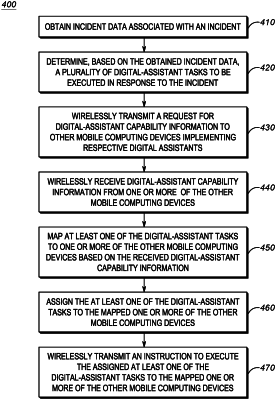| CPC G06F 9/5055 (2013.01) [G06F 9/505 (2013.01); G06F 9/5038 (2013.01); G06F 2209/5021 (2013.01)] | 14 Claims |

|
8. A method of assigning a digital-assistant task in response to an incident, the method comprising:
obtaining, at a mobile computing device, video data associated with an incident, the video data captured by a video camera implemented at the mobile computing device;
analyzing, via a video analytics engine implemented at the mobile computing device, the video data and detecting a first person, object, or entity of interest captured in the video data and a second person, object, or entity of interest captured in the video data;
determining, at the mobile computing device, based on the obtained video data, a plurality of digital-assistant tasks to be executed by a plurality of other mobile computing devices in response to the incident, the plurality of digital-assistants tasks including a first video analytics task to detect a condition or a status of the first person, object, or entity of interest detected in the video data and a second video analytics task to detect a condition or a status of the second person, object, or entity of interest detected in the video data;
determining, at the mobile computing device, that a connection to a dispatch server is not available;
in response to the determination, establishing a direct-mode wireless connection with each of the plurality of other mobile computing devices to obtain the digital-assistant capability information;
wirelessly transmitting, at the mobile computing device, a request for digital-assistant capability information to the plurality of other mobile computing devices implementing respective digital assistants;
wirelessly receiving, at the mobile computing device, digital-assistant capability information from a first mobile computing device and a second mobile computing device of the plurality of other mobile computing devices, the digital-assistant capability information including device capability, software capability, and network capability of the respective digital assistants implemented at the first and second mobile computing devices;
determining, at the mobile computing device, without input from the dispatch server, based on the digital assistant capability information respectively received from the first and second mobile computing devices, that the first and second mobile computing devices are capable of respectively executing the first video analytics task and the second analytics task, the digital-assistant capability information identifying device capability, software capability, and network capability;
assigning, at the mobile computing device, the first video analytics task to the first mobile computing device and the second video analytics task to the second mobile computing device;
identifying a first set of one or more frames of the video data and a second set of one or more frames of the video data, the first set of one or more frames of the video data containing only video data relevant to the first person, object, or entity of interest and the second set of one or more frames of the video data containing only video data relevant to the second person, object, or entity of interest;
transmitting, at the mobile computing device, a first instruction requesting the first mobile computing device to execute the first video analytics task to detect a condition or a status of the first person, object, or entity of interest detected in the first set of one or more frames of the video data, the first instruction including the first set of one or more frames of the video data, a priority level of the first video analytics task, and information identifying the type of video analytics task; and
transmitting, at the mobile computing device, a second instruction requesting the second mobile computing device to execute the second video analytics task to detect a condition or a status of the second person, object, or entity of interest detected in the second set of one or more frames of the video data, the second instruction including the second set of one or more frames the video data, a priority level of the second video analytics task, and information identifying the type of video analytics task.
|